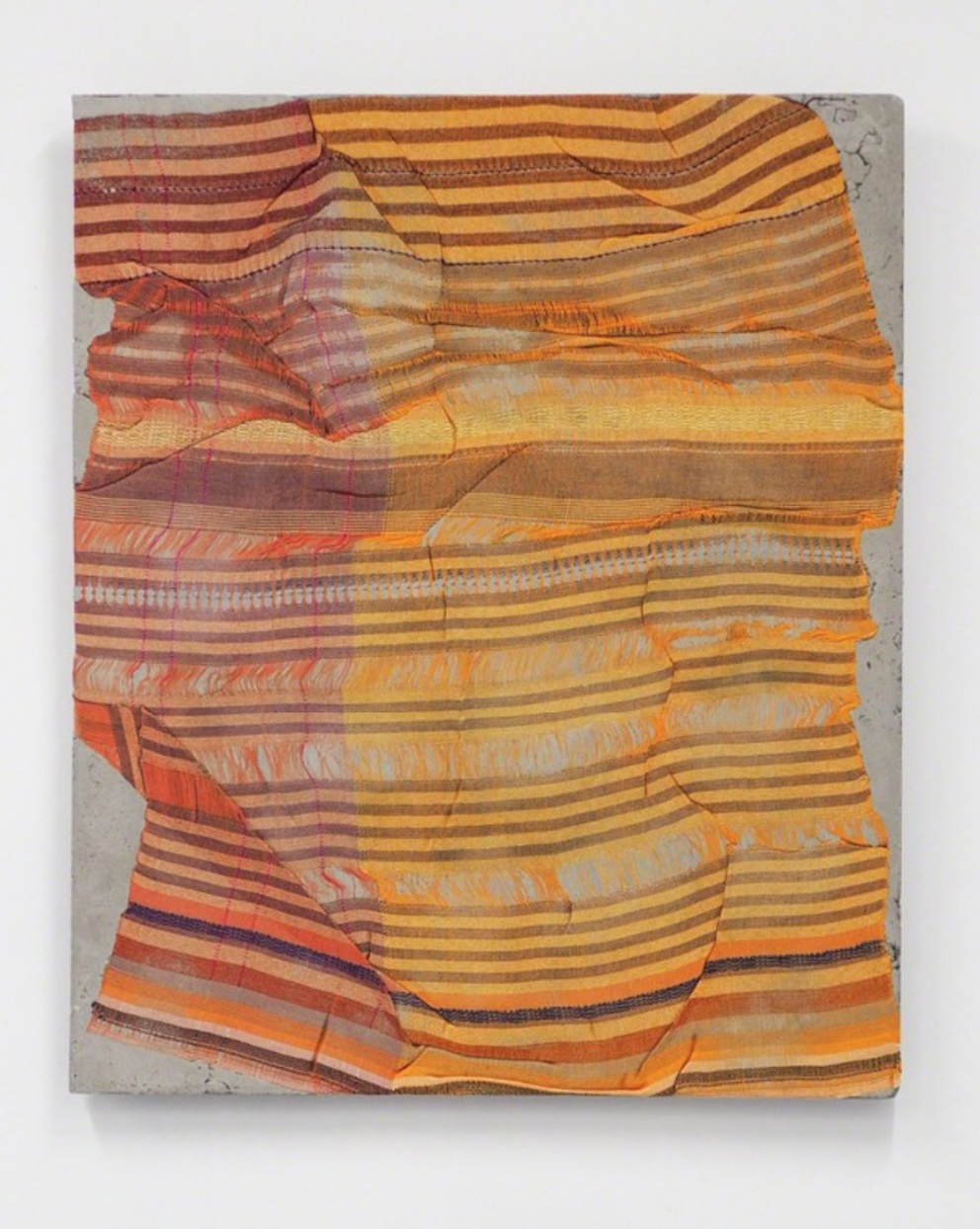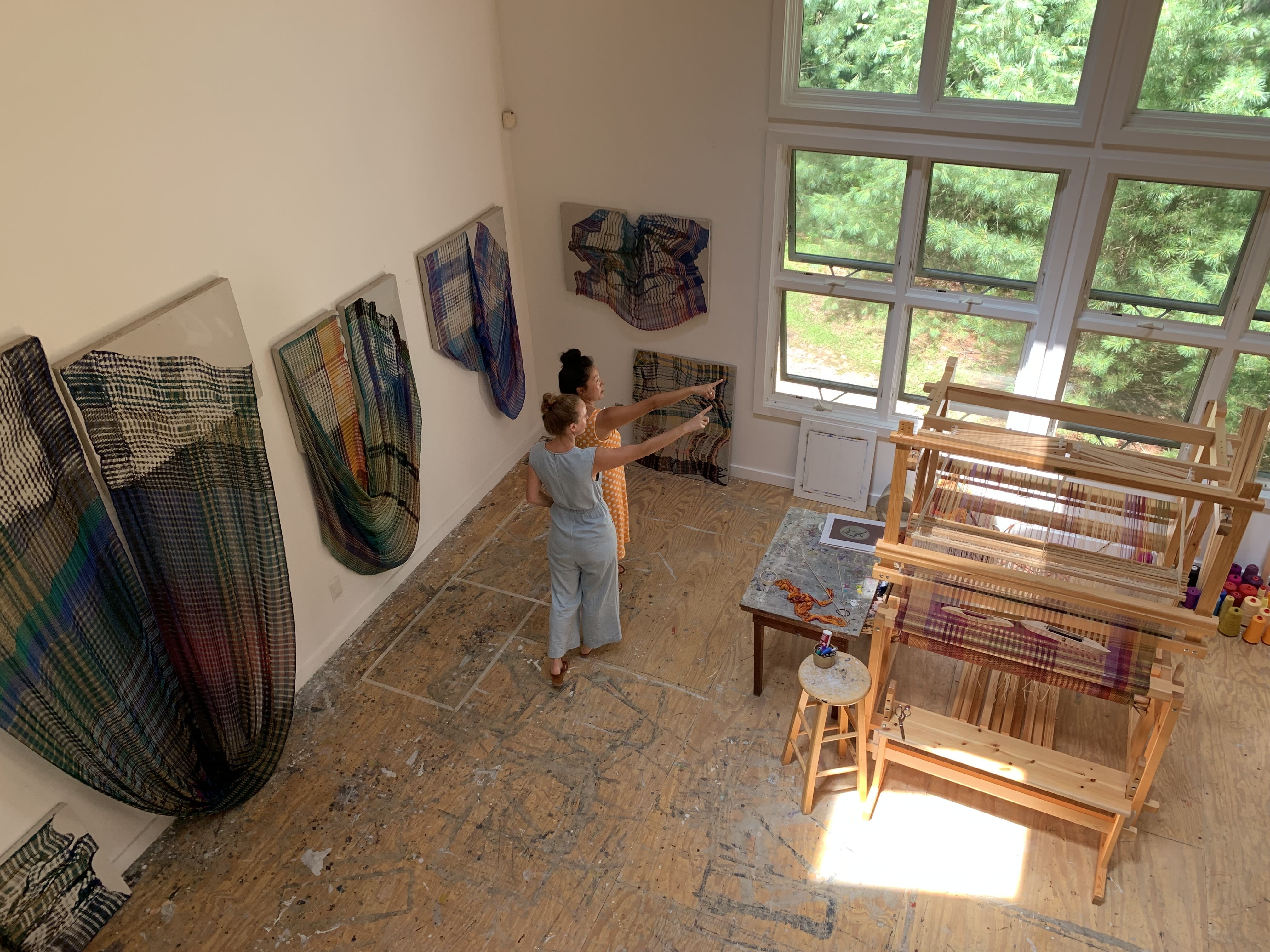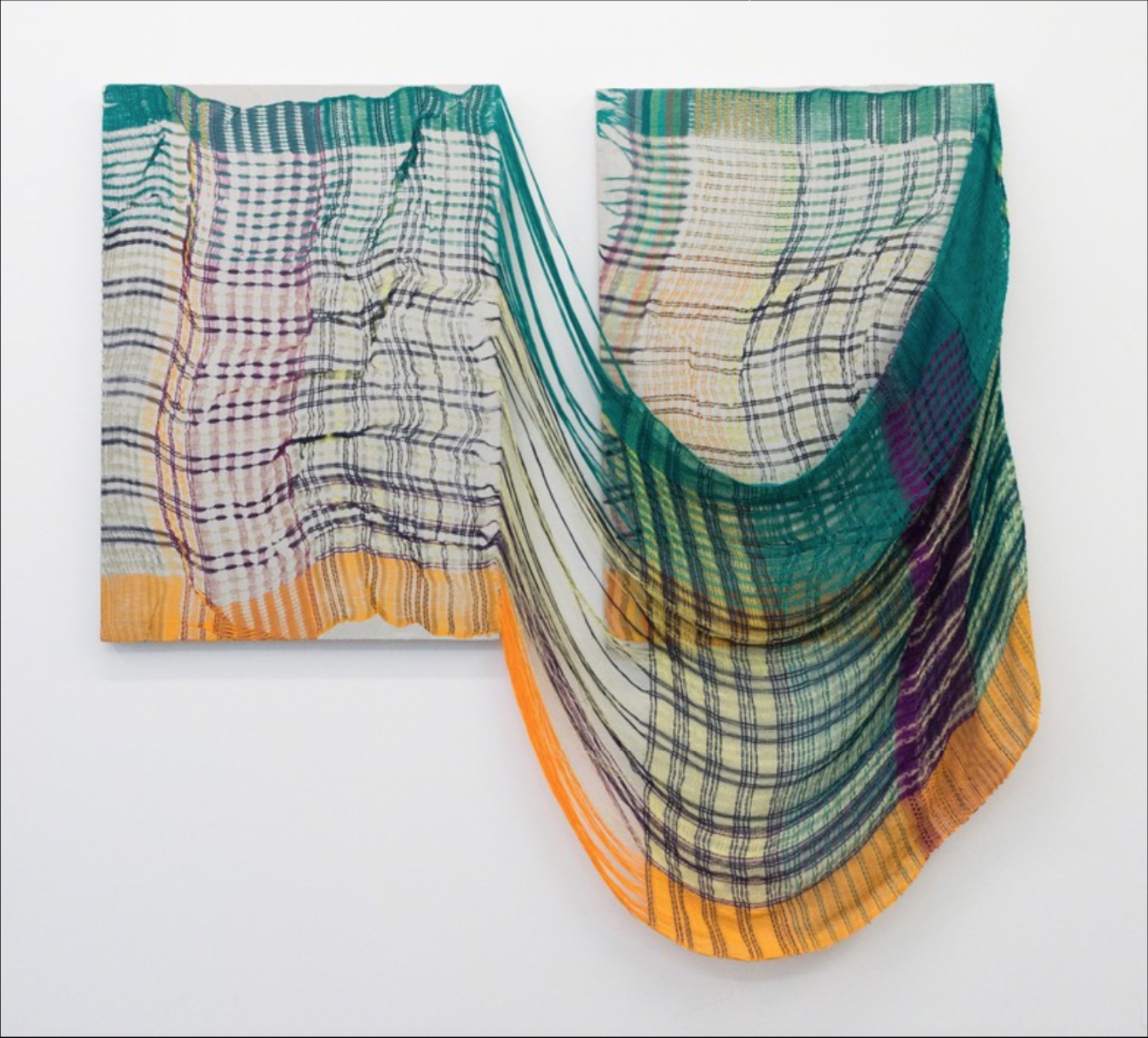MOMENTUM GALLERY INTERVIEWS CRYSTAL GREGORY

(photo credits: Stephanie Land)
Momentum Gallery inaugural artist, Crystal Gregory, is a fiber artist and sculptor dividing her time between Brooklyn, NY and Lexington, KY. She received her BFA from the University of Oregon and her MFA from the Art Institute of Chicago via a full Merit Scholarship. Gregory's seemingly weightless sculptures often explore the feminine qualities of fiber juxtaposed with the masculine qualities of industrial materials like concrete and iron. The artist recently completed a residency with the Josef and Anni Albers Foundation, where she explored the limits of fibers and the history of the widely celebrated material in a collection of new works.
Josef and Anni Albers are known for their impressive work with the Bauhaus School, an early 20th-century Avant-Garde school in Germany focusing on innovative design and crafts, and Black Mountain College, a school outside Asheville that incubated a number of the most progressive and influential creatives in the mid-20th century. Crystal Gregory is particularly inspired by renowned fiber artist, Anni Albers, known for blurring the lines between traditional craft and art. Anni was first a student of weaving at the Bauhaus and later invited onto the faculty, helping to propel the weaving department to world-class standards.
With World War II approaching, the Bauhaus closed its doors in response to harsh regulations under Nazi regime. Upon immigrating to the US, Josef and Anni Albers were invited to join the faculty of Black Mountain College where they ultimately encouraged students to experiment with materials and push the boundaries of craft. Anni founded the weaving workshop at BMC, and while writing, teaching, and making art herself, she introduced a new type of curriculum, defined by John Dewey's exhortation to "learn by doing."
Crystal Gregory's residency in the summer of 2019 delved into the works of Anni Albers and a portion of her research was conducted here in Asheville at The Black Mountain College Museum + Art Center. Having just completed this residency, Gregory is excited to share some thoughts on and the inspiration behind her latest series.
MG: When did you first know you wanted to be an artist?
CG: I have always been curious about and driven to make things, but it wasn't until I moved to New York City that I understood it as an identity, a career, and a lifestyle. New York City was a completely liberating and compelling place to spend my 20s. The people I met and love there are driven and passionate and excited to pursue their dreams. This energy ignited a confidence in me that I hope to pass forward.
MG: What first drew you to working with fiber and concrete? Is there a particular message you think these materials convey individually and together?
CG: My work uses cloth construction as a fundamental center, a place to start from and move back to. With a background in weaving, I see myself as a builder. I draw a clear connection between the lines of thread laid perpendicularly through a warp and the construction of architectural spaces.
In The Pliable Plane, Anni Albers considers architecture in relationship to woven textile. If the nature of architecture is the grounded, the fixed, the permanent, then textiles are its very antithesis. If, however, we think of the process of building and the process of weaving and compare the work involved, we will find similarities despite the difference in scale. Functionally, both divide space and create shelter. Both are created from individual parts which retain their identity - brick by brick or thread by thread. Textile, however, has the advantage of flexibility. It is a semi two-dimensional plane that has the ability to be folded, draped, moved, and changed to its surroundings. It is pliable. It is moveable.
In these works, I challenge myself not only formally and technically but as a thought exercise. Both materials are drenched in collective experience. We know and understand these materials because they surround us in our everyday. Maybe because of this familiarity they are charged with specific identities; hard/soft, strength/pliability, cold/warmth. Through our materials we come to understand these words; to wrap our experiences in them to use them in speech to express to one another. My work is to go deep into these understandings and try to tease out how they color our world, our relationships, and our attitudes.
MG: Were there any challenges with finding a way to engineer fibers and concrete to coexist so seamlessly?
CG: Definitely. I have been working in this series (among others) for over five years now. In that time, I have learned a lot about both materials. Weaving is a forever process and although I have been weaving for almost fifteen years, I only obtain a drop in the well of her vast knowledge. She keeps teaching me every time I come to the loom. Concrete is an antithetical process to that of weaving. Where one is slow and meditative the other is fast and unforgiving.

MG: You've also explored glass as a material. Can you tell us about those experiences?
CG: I was so thrilled to have been invited to be an artist in residence at Corning Museum of Glass in March of 2018. There I worked with a team of glass blowers headed by Eric Meek to produce of series of glass textiles. I was interested in working in glass as a vehicle to think through the similarities between the properties of glass and those of textiles - structure, pliability, strength, translucency, vulnerability. Through this comparison important and interesting embedded understandings surfaced.
What has become interesting to me was thinking of these forms in the relationship to the hand of a fabric. The hand of a fabric refers to the feel of the fabric against your skin. There are many adjectives that can be used to describe the hand, or feel, of a fabric. Words like cool, slick, smooth, loose, stiff, heavy, and stretchy can all be used to tell someone about the hand of a fabric. In relation to glass these adjectives talk about not only the material process, but the relationship between the material and the body.
The result of this work were five pieces that resembled folded and stacked fabrics. The series undulated color and patterns mimicking those of woven fabrics but in a cool hard and breakable material.
MG: You received a full merit scholarship for the Art Institute of Chicago for your MFA, how did that program impact your work?
CG: My grad school experience shaped my life as well as my art practice. I was able to work with incredible artists and now mentors like Anne Wilson, Christine Tarkowski, Diana Guerrero-Maciá as well as a truly wonderful group of peers. Those two years in Chicago challenged me in ways I could never have expected, and I believe are still teaching me.

MG: You teach at the University of Kentucky; do you have a favorite lesson or piece of advice you give to your students?
CG: Every day and every person is different, which is part of what makes teaching interesting. I do love to teach weaving though. I find that people can lean on the structure and the rhythm of making a cloth to find a certain freedom. It takes time, concentration and focus and through that practice many unconscious ideas arise. The textile is often only the vehicle that allows you to tap into what is deeper.
MG: Is there a particular material you would like to work with more in the future?
CG: I have been thinking a lot about the knitting machine and looped structures. I love the metaphor it builds of making a plane out of a single line. The grace it captures through this shapeshift. It bends and folds back on itself making interlocking loops that work together to form a material with elasticity.
MG: What do you hope clients and viewers will take away from your work?
CG: I don't know if I have a good answer to this question. Making to me is very personal and I think looking is as well. We all come to our present moment through a history of experiences. And use those experiences to understand the moment. My work, I believe, lives in a realm of universal experiences because of the materials I choose. I guess I hope to draw attention to that by representing them to the viewer in an unfamiliar way, allowing for a re-recognition whatever that means to the individual.

MG: Can you tell us a little bit about your recent residency at the Joseph and Anni Albers Foundation?
CG: June and July (2019) were spent as artist in residence at the Albers Foundation. The Foundation maintains two residential studios for visiting artists who exemplify the seriousness of purpose that characterized both Anni and Josef Albers. Residencies are designed to provide time, space, and solitude, with the benefit of access to the Foundation's archives and library. Residencies are awarded by invitation and by application.
My time at this residency was entirely focused on thinking and making and for that was extremely productive. There I competed a new body of work of woven concrete constructions which will be exhibited across the country as well as in the Netherlands over the next 6 months.
I also had the time and space to develop a new project titled Pliable Plane. This project is a collaboration between a modernist dance group, the Moving Architects, and myself. The work is of a monumental scaffolding structure interwoven with a complex textile. The dancers will interact and change the shape and environment of the sculpture through movement.

MG: What originally inspired you about the work of Anni Albers? What did you learn at Black Mountain College and Arts Center?
CG: Anni Albers was and continues to be a hugely influential artist not only because of her works, but because of her philosophies, the way she wrote and the ways she taught. From Bauhaus to Black Mountain College, Albers was an advocate for experimentation and invention not only in the field of art but also in education.
With a grant from the Great Meadows Foundation I traveled to Asheville, NC in March of this year. During my time there I was able to visit the exhibition, Politics at Black Mountain College, which looked closely at "the politics surrounding the college and its controversial faculty and students." This exhibition was inspiring and gave world context of how and why this revolutionary school developed at that point in history. The exhibition looked at global politics and how with WWII being fought in Europe, the school was able to create a place that held space for the cultivation of creativity and experimentation. The exhibition looked at race and gender politics within the context of the school as well as within the American South during the 1930's and 40's.
On the second day, I got to spend an afternoon visiting with the program director Alice Sebrell. Alice is incredibly passionate about Black Mountain College and spent time showing me the textiles that came out of the weaving studio. This was a highlight of my trip.
What interested me the most in my visit was a notebook kept by one of Anni Albers students while at Black Mountain College. The notebook was a clear articulation of different woven interlacements, drafts and notes on content of the class. This was such a wonderful object to get to spend time with. It allowed me insight into how Albers' philosophies on weaving were presented within a course of study. I teach a course titled Woven Structure at the University of Kentucky, and I look forward to sharing this with my students.

MG: Is there a particular work of Anni's or moment in her career that speaks to you the most?
CG: That is a great question. This answer might change over the years, but for now it is no. I am inspired by the wholeness of her career. Her persistence, her process and her dedication as her focus undulated from weaving to writing to print and back again. I admire her insight and ability to go deeply into what she studied.
MG: Is there anything you would ask Anni if she were still alive?
CG: I believe it would be my job in that relationship to listen. I think that may be the most profound thing she taught, even if she never quantified it in those terms. She asked herself, her readers, her students to listen to the materials and respond to what they are saying. This is a forever challenge not to be overlooked.
MG: What do you think a major takeaway from this project was and how do you think it will impact your future work?
CG: My time at the Albers Foundation was incredibly grounding. My goal is to take with me that level of insight and the silence it takes to do the work and to do the listening back into my hectic day-to-day life.
MG: Thank you for your time, Crystal.
